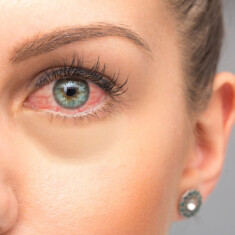What Are Meibomian (Oil) Glands?
Meibomian glands are the tiny oil glands that line the margin of the eyelids (the edges which touch when the eyelids are closed). These glands secrete oil which coats the surface of our eyes and keeps the water component of our tears from evaporating (drying out). Together, the water and the oil layer make up the tear film.
In addition to lubricating our eyes, the tear film affects how we see. Symptoms of irritation and/or blurred vision may occur if either the oil or water layer is reduced or is of poor quality.
What Is Meibomian Gland Dysfunction (MGD)?
Meibomian Gland Dysfunction (MGD) refers to the condition where the glands are not secreting enough oil or when the oil they secrete is of poor quality. During the early stages, patients are often asymptomatic but if left untreated, MGD can cause or exacerbate dry eye symptoms and eyelid inflammation. The oil glands become blocked with thickened secretions. Chronically clogged glands eventually become unable to secrete oil which results in permanent changes in the tear film, symptoms of eye irritation, and inflammation. Bottom line: MGD is the most common cause of dry eye syndrome.
What causes Meibomian Gland Dysfunction?
The condition can be caused or exacerbated by a number of factors. The environment is one, especially if the air is dry or polluted. Contact lenses can also dry out your eyes as can some medications. In some cases, hormonal imbalances may be the cause.3
What can you do about Meibomian Gland Dysfunction?
You can start by getting diagnosed by a dry eye specialist , and home remedies such as compresses and eye drops are common yet in many cases only provide temporary relief. Handling MGD in this manner requires on-going, consistent, and daily treatment which is not in line with most people’s busy schedule. Luckily, there’s an alternative.
OptiLIGHT – a real solution for dry eyes due to MGD
Lumenis light therapy is the first and only FDA-approved for dry eye management. OptiLIGHT uses patented Optimal Pulse Technology (OPT™) to reduce the inflammation that is typically associated with dry eye disease. It alleviates abnormal blood vessels that contribute to inflammation, and reduces the amount of Demodex mites and bacteria living around your eyes. The benefit to the busy person is that it does all this in a treatment regimen of 4 sessions that take around 15 minutes each and it reduces dependency on eye drops. OptiLIGHT provides a real and effective solution for dry eye sufferers due to Meibomian Gland Dysfunction, through a clinically proveni gentle treatment, which is backed by more than 40 clinical studies.
The way forward is personal
There are many people who find taking eye drops or antibiotics time-consuming and difficult to fit into their schedule. Moreover, these treatment options don’t necessarily provide a solution to their dry eye condition. The good news is that they don’t have to. OptiLIGHT, by Lumenis, is more effective and time-saving.
How would you know if OptiLIGHT is right for you? Get started by contacting a dry eye specialist near you.







